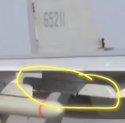More images are needed, from different angles, so we can deduce the dimensions (length and clearance from the wing) of the pylon. Just because the general shape is similar doesn't have to mean it's made for the same missile.
Though, a new pylon type an also mean a new, yet unseen, missile. Maybe not YJ12 but something smaller. Yet, evidently, larger than KD88 family, as otherwise a new pylon might not be needed.
To get back to those photos of seemingly YJ83K. I'd say we were looking at a training round. Not sure if colored rings represent training round or a live round but if there was a radar there, the nose of the missile would have a radome of slightly different color. In addition, the engine inlet doesn't seem to have an opening. And the whole missile is a bit too perfect, devoid of details.
Now, while it's perfectly possible it's indeed a training round meant to stand in for an antiship missile, there are other possibilities as well (listed in no particular order). It could be a training round for a variety of new variants of the KD88/YJ83 body types:
- a cheap stand off precision bomb with an engine. Some would say a missile, but French AASM is basically a rocket motor powered GPS/INS missiles in one of its variants yet it's still referred to as a bomb. if the same range is retained as in other variants, circa 250 km, it'd make it the longest reach such weapon but it may A) have less range due to internal differences, like for example a larger, heavier warhead?) and B) extra reach over the other long reach GPS/INS bombs such as AASM, JSOW and SDB I may make sense to PLAAF due to perceived difficulties of getting closer than 200+ km to target and expecting to survive often enough. Why retain the jet engine? Perhaps using a rocket motor would involve so many changes in design and development that it was deemed cheaper and faster to just go with the jet engine, even though a rocket motor is cheaper per item basis. And jet engine would likely still retain range edge over a cheaper rocket motor solution.
- same as above, but perhaps longer range could be achieved if no special seeker, aside from GPS/INS is used. Perhaps with a different, lighter warhead, ranges comparable to JASSM could be achievable. Of course, capability would not be the same, as JASSM also has a terminal optical seeker, but as far as I can tell, that one is more similar to what Tomahawk has. To basically be able to take snapshots of target so damage assesment can be made. In any case, there are tomahawk variants which don't use any sort of terminal seekers - so overall precision may still be acceptable.
- an expensive stand off precision bomb. Basically a new variant of KD88. But one which instead of an optical seeker uses a radar one. Sometimes such class of weapons do opt for radar seekers, as they can offer better all weather capabilities and can be less susceptible to various smoke screens and heat decoys. (while being more susceptible to radar jamming, of course. One might argue that due to their price, radar jammers would be less used by the enemy compared to smoke/IR decoys) Brimstone II, for example, has a variant which uses just a MMW radar, and yet the missile is to be used from over 40 km away, when fired from a fixed wing platform. Using GPS/INS to get to 40 km or so off the target should yield the same kind of precision as Brimstone can count on, as there's no reason the seeker can't find the final location of the target on its own. And brimstone has been used against buildings, not just just high contrast targets such as vehicles.
Russians have a history of using radar seekers for air to ground weapons as well. Kh-38MAE (which is actually not that much smaller and has similar shape layout) and Kh-59MK missiles.





